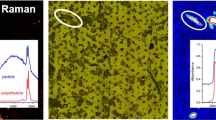Summary
The determination of lead isotope ratios can be used for source and pathway characterization of lead in the environment. The suitability of inductively coupled mass spectrometry (ICP-MS) was evaluated for the measurement of 206/207Pb isotope ratios in several marine compartments as marine aerosols from different source regions and suspended particulate matter from the North Sea. Two different ICP-MS systems were used to carry out these investigations. First optimization studies have been performed to yield a sufficient precision (RSD <0.5%) in combination with a reasonable measuring time. This study has been carried out using the standard reference material NBS 981 with certified lead isotope ratios. Furthermore, it could be shown for marine environmental samples, that a precision of less than 0.5% RSD is attainable for counting rates of above approximately 50000 cps. As the following measurements of lead isotope ratios in marine aerosols from main source regions surrounding the North Sea demonstrated, this precision is sufficient to determine significant differences due to the origin of atmospheric lead. The analysis of aerosol samples revealed isotope ratios varying from as low as 1.10, which is close to that ratio for leaded gasoline in Europe to near background (modern lead) values of 1.20. The lead isotope ratios for the investigated suspended particulate matter ranges between 1.13 and 1.18. These values can be related to the solid discharge, the urban density and anthropogenic activity of the drainage basin.
Similar content being viewed by others
References
Angrick M (1992) Entsorgungspraxis 1–2/92:27
Pacyna JM, Münch J, Axenfeld F (1991) In: Vernet J-P (ed) Heavy metals in the environment, vol 1. Elsevier, Amsterdam, pp 1–20
Maring H, Settle DM, Buat-Ménard P, Dulac F, Patterson CC (1987) Nature 300:154–156
Lambert CE, Véron A, Buat-Ménard P, Heyraud M, Grousset F, Simpson W (1991) Oceanologica Acta 14:67–76
Flegal AR, Rosman KJR, Stephenson MD (1987) Environ Sci Technol 21:1075
Flegal AR, Nriagu JO, Niemeyer S, Coale KH (1989) Nature 339:455
Sugden CI, Farmer JG, Mackenzie AB (1991) In: Farmer JG (ed) Proc Int Conf heavy metals in the environment. Elsevier, Amsterdam, pp 1–90
Sugden CI, Farmer JG, Mackenzie AB (1991) In: Farmer JG (ed) Proc Int Conf heavy metals in the environment. Elsevier, Amsterdam
Kersten M, Förstner U, Krause P, Kriews M, Dannecker W, Garbe-Schönberg C-D, Höck M, Terzenbach U, Graßl H (1992) In: Vernet J-P (ed) Impact of heavy metals in the environment. Elsevier, Amsterdam, p 311
Longerich HP, Fryer BJ, Strong DF (1987) Spectrochim Acta 42B:39–48
Price Russ III G, Bazan JM (1987) Spectrochim Acta 42B:49–62
Kriews M, Naumann K, Dannecker W (1988) J Aerosol Sci 19:1051
Kriews M, Bergmann M, Naumann K, Dannecker W (1991) In: Welz B (ed) 6. Colloquium Atomspektrometrische Spurenanalytik, p 725
Kriews M (1992) Charakterisierung mariner Aerosole in der Deutschen Bucht sowie Prozeßstudien zum Verhalten von Spurenmetallen beim Übergang Atmosphäre/Meerwasser. In: Dannecker W (ed) Schriftenreihe Angewandte Analytik, Bd 15. Institut für Anorganische und Angewandte Chemie, Universität Hamburg
Calmano W, Förstner U (1983) Sci Total Environ 28:77–90
Turner A, Millward GE, Morris AW (1991) Estuarine Coastal Shelf Sci 32:325–346
Kersten M, Irion G, Förstner U (1991) In: Vernet JP (ed) Heavy metals in the environment, vol 1. Elsevier, Amsterdam, pp 137–159
Ketterer ME, Peters MJ, Tisdale PJ (1991) J Anal At Spectrom 6:439
Kriews M, Krause P, Falke M, Terzenbach U, Dannecker W, Graßl H (1993) Atmos Environ (in preparation)
Nicholson RA, Moore PJ (1981) In: Postma H (ed) Sediment and pollution interchange in shallow seas. Rapp P-V Réun Cons Int Explor Mer 181:35–48
Chow TJ, Snyder CB, Earl JL (1975) In: Proc IAEA Symposium 2 on isotope ratios as pollutant source and behaviour indicators. IAEA Rep SM-191/4:95–108
Kersten M, Kriews M, Förstner U (1991) Mar Chem 36:165–182
Stukas VJ, Wong CS (1981) Science 211:1424–1427
Kersten M, Kriews M, Kühn W, Rick H-J (1992) In: Sündermann J (ed) Circulation and pollutant fluxes in the North Sea. Springer, Berlin Heidelberg New York (in press)
Smith DR, Niemayer S, Estes JA, Flegal AR (1990) Environ Sci Technol 24:1517–1521
Author information
Authors and Affiliations
Rights and permissions
About this article
Cite this article
Krause, P., Kriews, M., Dannecker, W. et al. Determination of 206/207Pb isotope ratios by ICP-MS in particulate matter from the north sea environment. Fresenius J Anal Chem 347, 324–329 (1993). https://doi.org/10.1007/BF00323815
Received:
Revised:
Issue Date:
DOI: https://doi.org/10.1007/BF00323815




